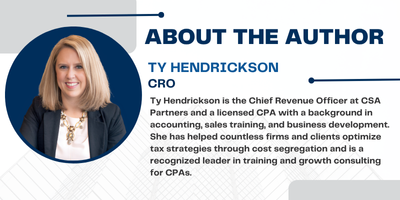As a business owner, purchasing the building or condo where your business operates is a bold and strategic move. It gives you more control, offers potential long-term appreciation, and allows you to invest in your own equity instead of a landlord’s. But what many business owners don’t realize is that the tax benefits of property ownership go far beyond standard depreciation.
Enter cost segregation, a powerful, IRS-approved tax strategy that can significantly accelerate your depreciation deductions, improve cash flow, and make owning your building even more financially rewarding.
In this guide, we’ll walk through what cost segregation is, how it works, when to use it, and what every business owner needs to know to take advantage of it.

What Is Cost Segregation?
Cost segregation is a specialized tax strategy that allows property owners to reclassify certain components of their building from a 39-year depreciation schedule (for nonresidential real estate) to shorter lives, typically 5, 7, or 15 years.
Why does that matter? Because assets with shorter depreciable lives can be deducted more quickly, front-loading your tax deductions into the early years of ownership. That means more cash in your pocket now, not 30 years from now.
Rather than slowly depreciating the entire building over nearly four decades, a cost segregation study identifies and separates out components like:
- Flooring, cabinetry, and interior finishes (5-year property)
- Parking lots, sidewalks, and landscaping (15-year property)
- Specialized plumbing, electrical, or HVAC systems connected to business operations
The result: potentially significant accelerated deductions, especially when combined with bonus depreciation.

Who Should Consider It?
Cost segregation is a smart strategy for business owners who:
- Bought or built the commercial property their business operates in
- Renovated or improved their existing space
- Use the building for operations, not just as an investment
- Want to reduce taxable income and improve cash flow
Whether you’re a dentist, a restaurant owner, a retailer, or a professional services provider, owning your commercial space creates a unique opportunity to take advantage of this tax-saving approach.

When Can You Do a Cost Segregation Study?
The timing is flexible. A cost segregation study can be completed:
- In the year you purchase or place the property in service
- When you construct a new building
- After you complete renovations or improvements
- Retroactively, even years after you acquired the property
If your building has already been placed in service in a prior year, you can perform a “look-back” study and file IRS Form 3115 to catch up on missed depreciation, without amending past returns. This often results in a large, one-time deduction in the current year.

How the Process Works
A cost segregation study is typically performed by engineers or specialists familiar with both construction and tax law. The process usually includes:
- Property Review – Gathering details about your building, including how it’s used in your business.
- Site Inspection – A walkthrough to assess the building’s components, systems, and finishes.
- Engineering Analysis – A breakdown of assets that can be classified into shorter depreciation schedules.
- Final Report – A comprehensive, audit-ready document that your CPA will use to adjust depreciation on your tax return.
The study integrates seamlessly with your existing tax filing process and does not require amending prior returns for retroactive studies.

The Role of Bonus Depreciation
Bonus depreciation is the key accelerator that makes cost segregation even more powerful. As of 2024, it allows business owners to immediately deduct 60% of the value of eligible shorter-life assets identified in a cost segregation study.
That means significant tax savings in the year the property is acquired or improved.
For example, if your study identifies $200,000 worth of 5- and 15-year property, 60% of that, or $120,000, can be deducted in year one, with the remainder depreciated over time.
Even as bonus depreciation phases down in future years (40% in 2025, 20% in 2026, unless extended), cost segregation still provides meaningful upfront tax benefits.

Real-World Benefits for Business Owners
Let’s say you buy a building and move your business in. A cost segregation study reveals that a portion of the building, everything from interior finishes to site improvements, can be depreciated over shorter periods. That reduces your taxable income, which in turn:
- Frees up cash flow
- Reduces quarterly estimated tax payments
- Allows reinvestment in staffing, marketing, or equipment
- Strengthens your business’s financial flexibility
And if you’ve renovated your space, added treatment rooms, expanded your kitchen, upgraded lighting, or repaved the parking lot, those improvements may qualify for shorter depreciation, too.

What Business Owners Need to Know
Here are key considerations:
- It’s not just for large buildings or big companies, even small business owners can benefit
- You can do it even if you bought the property years ago
- Bonus depreciation enhances the value, but even without it, the strategy still works
- Recapture at sale is a factor, but with good planning (e.g., using a 1031 exchange), you can defer or minimize its impact
- You don’t have to do it alone, a reputable provider will coordinate with your CPA and handle the technical aspects

Common Questions
Is cost segregation risky?
Not if done properly. It’s an IRS-approved method, and thousands of studies are completed annually. The IRS even provides an audit guide for cost segregation. Choose a firm that provides a detailed, engineering-based report with full documentation.
Do I need special records?
Typically, you’ll need your closing statement, depreciation schedule, renovation invoices (if applicable), and basic building information. The provider will guide you through what’s needed.
What if I lease part of my building?
No problem. Many business owners lease out a portion of their space. Cost segregation applies to any portion of the property used in commercial operations, whether by you or a tenant.
What if I’ve already filed my taxes?
A “look-back” study allows you to apply the findings retroactively by filing a change in accounting method (Form 3115). You’ll take a one-time “catch-up” deduction in the current year without amending past returns.

A Quick Example
A small business owner purchases a commercial condo to house their law firm. A cost segregation study identifies several components—interior finishes, partition walls, specialized wiring—as 5- and 15-year assets.
The resulting deduction reduces their taxable income by tens of thousands of dollars, allowing them to reinvest in technology and staff without taking on debt or disrupting operations.

The Takeaway
Owning your business’s building is more than just a real estate investment, it’s a chance to create lasting tax savings that fuel growth. Whether you’ve purchased a building, completed renovations, or simply want to explore your options, cost segregation is a strategy worth considering.
The sooner you act, the more value you may be able to unlock, especially while bonus depreciation is still available.

Interested in Learning More?
At CSA Partners, we specialize in helping business owners like you maximize the tax benefits of property ownership. Whether your building is newly acquired, renovated, or has been in service for years, we can help determine whether a cost segregation study makes sense.
Let’s explore what you might be missing and how you can turn your building into a cash-flow advantage.

















